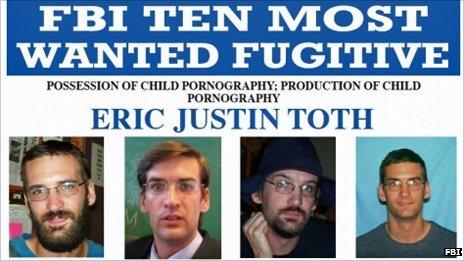Who, What, Why: Who gets on the FBI's 'top 10' list?
- Published

The FBI has replaced Osama Bin Laden with an accused child pornographer on its Ten Most Wanted list of fugitives. How does America's most prominent federal law enforcement bureau choose who is featured on the list?
Bin Laden was one of the world's most wanted terrorists before his death in a May US special forces raid in Pakistan. Eric Justin Toth, 30, is not accused of killing anyone, but of producing child pornography.
The former school teacher and camp counsellor has been on the run since 2008, when he was indicted on federal charges in the state of Maryland after child pornography was found on a camera he had used at a school, officials say.
The FBI has followed him through Illinois, Indiana and out west to Arizona, but the trail ran cold.
So on Tuesday, the bureau added Mr Toth to its Ten Most Wanted list, replacing the al-Qaeda leader who was killed by US forces last year.
"We have always counted on the public's support to help capture fugitives and solve cases," Mike Kortan, a bureau spokesman, said in a statement.
"The addition of Eric Toth to the Top Ten list illustrates how important it is to get this individual off the streets and into custody."
The FBI first drew up a Ten Most Wanted list in 1950 when a reporter asked the bureau for the names and descriptions of the "toughest guys" on the run.
Since then, the list has proven a remarkably successful publicity programme, FBI officials say.
Of 495 men and women on the list since then, 465 have been captured or located. Of those, 153 were nabbed after a tip from the public, the FBI says.
The ten individuals on the list are not ranked.
To be included on the list, a fugitive must have a federal warrant for his or her arrest and must be a real menace to society - someone with the capacity to do continued harm if he or she remains on the run. He or she must also be bad enough to warrant a $100,000 (£62,900) reward.
The case agents searching for the fugitive will have exhausted other leads and believe the publicity will help find him or her. (In cases that don't make the list, agents may feel they are closing in on the bad guy and the publicity will drive him further underground.)
The FBI adds fugitives to the list by canvassing its field offices for suggestions, analysing the most worthy cases, then forwarding those up the bureau's chain of command until they receive final approval from Director Robert Mueller.
"Over time, the top 10 list has in some ways mirrored the criminal investigative interests of the bureau and the priorities of the day," says John Fox, the bureau's official historian.
In the 1960s and 1970s, violent anti-Vietnam War radicals like Bernardine Dohrn, Katherine Power, and Leo Burt featured on the list, for example.
In the 1990s, international terrorists made the list, and since 2000, several alleged child pornographers and paedophiles have been listed.
"Of course, it doesn't capture all of what the FBI's priorities are," Mr Fox says.
"Counter-intelligence is not an investigative matter that is well suited to the Top Ten Most Wanted list."
Fugitives are removed from the list when they are captured, die (or are killed) or are removed because they are no longer considered a menace to society.
Over the years, six fugitives fell into that category; several of those were anti-Vietnam War activists accused of violent acts who evaded the law until they reached middle age.
The bureaucratic process of adding a new fugitive to the list can be lengthy.
The FBI took 11 months to replace Bin Laden. As of Wednesday, Bulger was still on the list, though he was captured in June.
Reporting by Daniel Nasaw in Washington